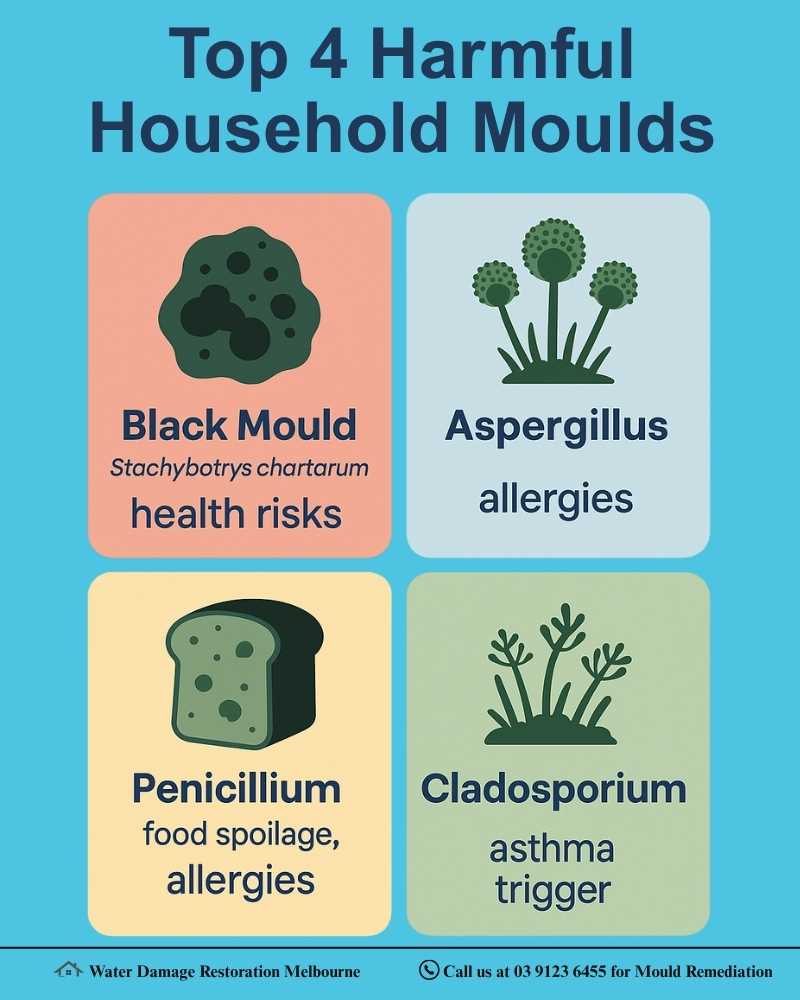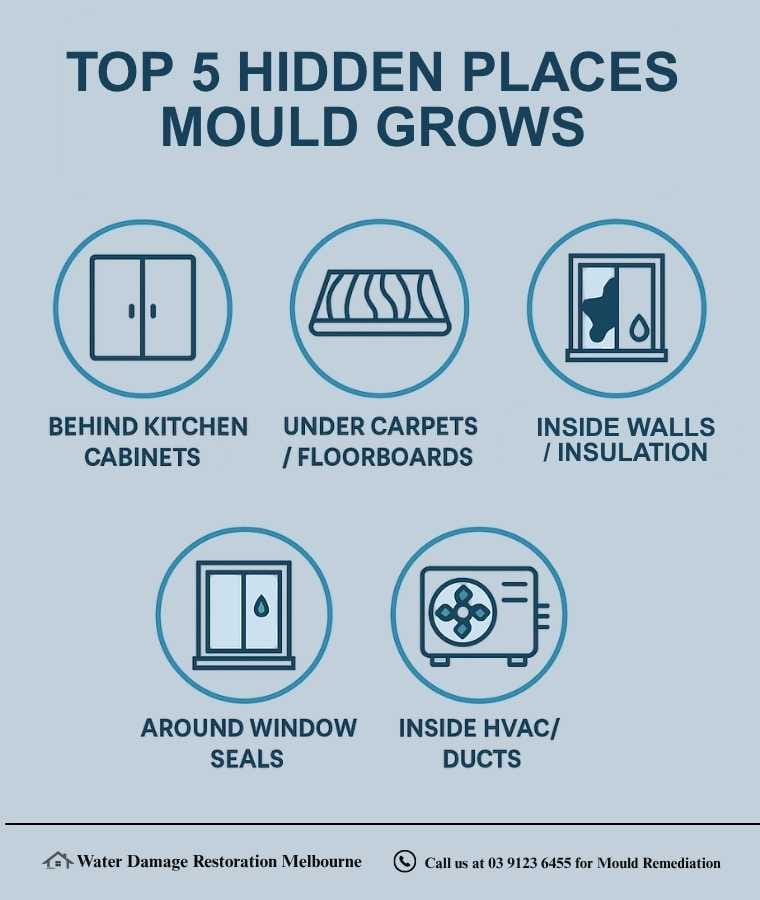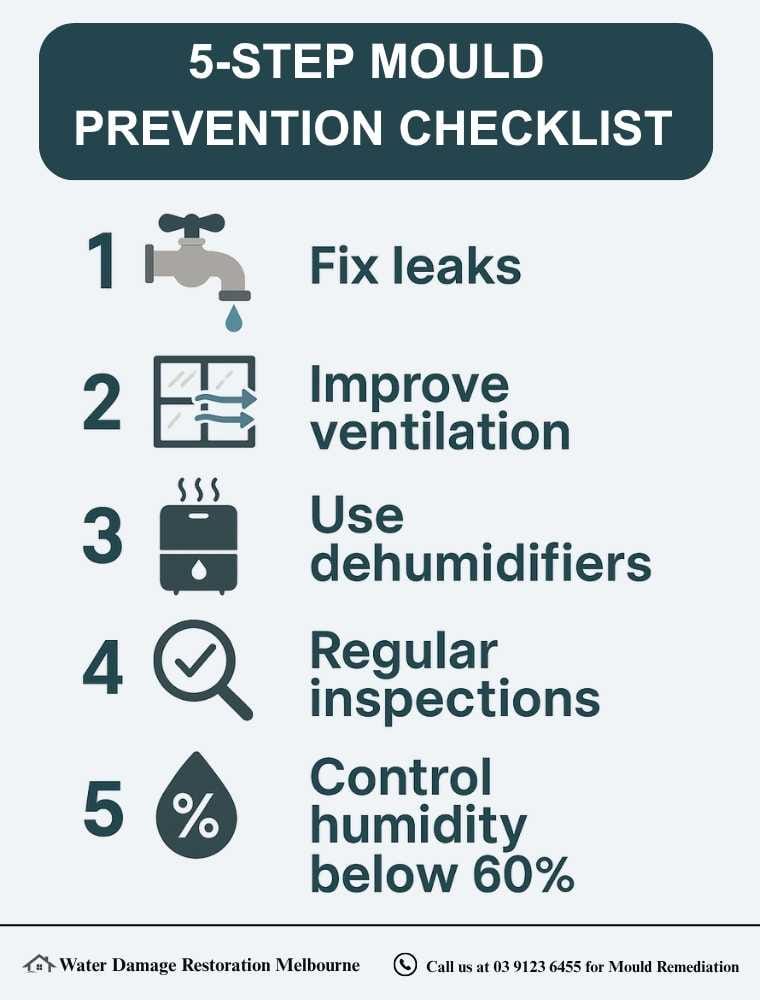Water Damage Restoration Melbourne has been helping homeowners, renters, and businesses for over 20 years to safely remove mould and stop it from coming back. Our friendly local team uses the right tools, treatments, and know-how to protect your health and property.
In this article, you’ll learn which moulds are risky, what health effects to watch for, and how to remove toxic mould safely. We’ll also explain when it’s time to call a mould expert, so you can act early and avoid bigger (and more expensive) problems.
Table of Contents
ToggleKey Takeaways
- Black mould, Aspergillus, Penicillium, and Cladosporium can trigger allergies, asthma, rashes, headaches, and respiratory issues.
- Mildew is surface-level and easier to clean, while mould penetrates deeper and poses greater health and structural risks.
- Small patches can be DIY-cleaned; large, hidden, or black mould needs professional removal with HEPA vacuums and antifungal treatments.
- Fix leaks, improve ventilation, reduce humidity, and schedule inspections, especially after water damage or in older homes.
What Types of Mould Can Make You Sick?
Not all mould is harmful, but certain types can pose serious health risks in your home, office, or commercial building.
- Black mould (Stachybotrys chartarum). One of the most feared mould species, black mould thrives in damp, hidden areas such as wall cavities, roof spaces, and under flooring. It produces mycotoxins that can trigger allergies, headaches, respiratory issues, and skin irritation, and poses a higher risk for babies, the elderly, and people with weakened immune systems.
- Aspergillus and Penicillium. These common indoor moulds often grow on damp walls, ceilings, carpets, and even stored food. They can cause mould allergy symptoms like sneezing, coughing, itchy eyes, or rashes, particularly in sensitive individuals.
- Cladosporium. Typically found on wood, textiles, HVAC systems, or air conditioning units. Cladosporium can irritate both skin and lungs, and is a known asthma trigger for many.
- Hidden mould in crawlspaces, roof cavities, and air-conditioning ducts. Even if invisible, mould colonies in these areas release airborne spores that circulate through the building, contributing to long-term health issues such as chronic cough, sinus congestion, or worsening asthma.

What’s the Difference Between Mould and Mildew?
Many homeowners wonder, “Do I have mould or just mildew?” and knowing the difference is important because they behave very differently.
- Mildew. Mildew is typically white or grey, thin, and powdery in texture. It grows on surface-level areas like shower tiles, windowsills, or bathroom walls and is usually easy to wipe away with basic cleaning.
- Mould. Mould, on the other hand, can appear black, green, or brown and penetrates deeper into walls, timber, carpets, insulation, and ceilings. It’s much harder to remove and can release airborne spores that pose health risks, such as allergies, respiratory problems, and skin irritation.
While mildew is generally a cosmetic and surface issue, mould can cause serious health effects and property damage if left untreated. That’s why correctly identifying which one you’re dealing with is crucial and why professional assessment may be needed when in doubt.
How Does Mould Affect Your Health?
Mould exposure can impact people in different ways, depending on their age, health, and sensitivity. According to CDC site, common health effects include:
- Respiratory symptoms – Sneezing, coughing, stuffy or runny nose, and sinus congestion.
- Eye and skin irritation – Red, itchy, or watery eyes; skin rashes or hives.
- Headaches and fatigue – Persistent headaches, brain fog, or constant tiredness.
- Worsened asthma or breathing issues – Asthma attacks, wheezing, or shortness of breath, especially in people with pre-existing lung conditions.
- Higher risk for vulnerable groups – Young children, elderly adults, and people with asthma, allergies, or weakened immune systems are more susceptible to mould-related illnesses.
Top Signs You Have a Hidden Mould Problem in Your House
- Persistent musty odour – A damp, earthy smell like wet socks or old books, often signals hidden mould behind walls, floors, or ceilings.
- Discoloured walls, peeling paint, or damp stains – Look for dark spots, yellow patches, bubbling paint, or cracked surfaces, which suggest trapped moisture and possible mould growth.
- Visible mould in high-moisture areas – Check around bathroom tiles, kitchen sinks, laundry rooms, and window seals for dark spots, fuzzy patches, or black mould buildup.
- Mould inside air conditioning systems or roof cavities – A musty smell when using the air conditioner may indicate mould inside ducts, vents, or roof spaces, circulating spores throughout your home.
- Ongoing allergies or respiratory symptoms – Unexplained sneezing, coughing, itchy eyes, skin irritation, or asthma flare-ups in household members can be linked to hidden mould exposure.
Quick Recap
- Musty, damp odour may signal hidden mould behind walls or ceilings.
- Discoloured walls, stains, or peeling paint point to trapped moisture.
- Dark or fuzzy spots in kitchens, bathrooms, or laundry areas indicate visible mould.
- Musty smell from air conditioning can mean mould in HVAC or roof cavities.
- Ongoing allergies or asthma flare-ups may be caused by hidden mould exposure.
Where Does Mould Commonly Hide in Homes and Businesses?
Many people wonder, “Where is the mould if I can’t see it?” but mould often thrives in hidden, moisture-prone areas you might overlook.
- Behind kitchen cabinets or bathroom vanities. Moisture from plumbing leaks can create ideal mould growth conditions in enclosed spaces.
- Under carpets or floorboards. Water-damaged subfloors or carpet padding can harbour mould colonies out of sight.
- Inside walls or insulation after leaks. Wall cavities and insulation can trap moisture from roof leaks, burst pipes, or rising damp, leading to hidden infestations.
- Around window seals and sliding doors. Condensation buildup on window frames and tracks can encourage mould near seals and frames.
- Inside air conditioning units or ductwork. Aircon systems and HVAC ducts can spread airborne mould spores throughout the property if contaminated.

How To Remove Toxic Mould Safely
For very small mould patches (typically smaller than your hand), you may be able to clean it yourself using protective gloves, a mask, and mild cleaning agents like vinegar or detergent. However, for larger infestations, hidden mould, or toxic species like black mould (Stachybotrys chartarum), it’s safer and more effective to call professional mould remediation experts.
At Water Damage Restoration Melbourne, we follow a comprehensive and proven mould removal process:
- Thorough property inspection and moisture detection – Identify the source of moisture, such as leaks, condensation, or rising damp.
- Safe mould removal using HEPA vacuums and antifungal treatments – Contain and remove mould spores without spreading contamination.
- Air cleaning with HEPA air scrubbers – Filter airborne mould spores and improve indoor air quality.
- Tailored mould prevention plan – Provide customised solutions, including moisture control advice, ventilation improvements, and maintenance recommendations to keep your home or business mould-free.
Bleach doesn’t kill mould roots on porous surfaces like drywall or wood, it only bleaches the surface. Professionals use antifungal agents that penetrate deeply.
What Else Should You Know About Mould Removal?
Before you decide on mould removal, here are some common concerns many homeowners have and what you need to know.
Can Mould Come Back After It’s Been Removed?
Yes, mould can come back after removal if the underlying moisture problem isn’t fixed. Even after professional remediation using antifungal treatments and surface decontamination, mould can regrow if there are ongoing issues like plumbing leaks, damp building materials (e.g., wood, drywall, insulation), or poor ventilation.
To prevent mould from returning:
- Repair plumbing leaks and seal cracks to block water intrusion.
- Improve ventilation systems, including exhaust fans and air vents, to lower indoor humidity.
- Use dehumidifiers in high-moisture areas like bathrooms and basements.
- Conduct regular moisture inspections and keep indoor relative humidity below 60%.
Key risk factors include:
- Indoor air quality (IAQ) issues
- Condensation on windows and walls
- HVAC systems that spread spores throughout the building
Effective mould management isn’t just about removal, it’s about solving root causes and maintaining long-term environmental control to protect health and building integrity.
How Long Does Mould Removal Take?
Mould removal can take anywhere from a few hours to several days, depending on the size of the affected area, type of mould, and extent of contamination.
- Small mould patches (e.g., on bathroom tiles or windowsills) – typically cleaned in a few hours using antifungal treatments.
- Medium-scale infestations (e.g., roof cavities, subfloor spaces, HVAC systems) – usually require 1–2 days, needing specialised equipment and access.
- Large or severe mould problems (e.g., multiple rooms, entire buildings, commercial spaces) – can take several days, especially if demolition, material removal, or structural repairs are involved.
Key factors affecting duration:
- Safety requirements – containment zones, air filtration units, personal protective equipment (PPE).
- Surface type – porous (e.g., drywall, insulation) vs. non-porous (e.g., tiles, metal).
- Moisture source complexity – hidden leaks, rising damp, condensation.
- Access difficulty – crawl spaces, ventilation ducts, attics.
Is It Safe to Stay in the House During Mould Remediation?
Yes, it’s usually safe to stay in the house during small, localised mould remediation, such as in a single bathroom or corner; if the work area is sealed off with containment barriers and negative air pressure systems.
However, for large infestations or cases involving toxic mould species like Stachybotrys chartarum (black mould), professionals often recommend temporary relocation during remediation. This is especially important for children, elderly adults, pregnant women, and pets, as they are more sensitive to airborne mould spores.
Talk to an Expert About Safe Remediation Options ➔What’s the Difference Between Professional Mould Removal and DIY?
The main difference is that professional mould removal handles both the visible mould and the root cause, while DIY only addresses surface-level patches.
DIY mould cleaning is only suitable for small, visible mould patches on non-porous surfaces like bathroom tiles, using store-bought mould cleaners.
Professional mould remediation offers key advantages:
- Thorough assessment – experts use moisture meters, thermal imaging cameras, and indoor air quality (IAQ) tests to detect hidden mould, including toxic types like Stachybotrys chartarum (black mould).
- Safe containment – setup of sealed barriers, negative air machines, and PPE to stop mould spore spread.
- Effective treatment – application of commercial-grade antifungal agents and biocides that penetrate porous materials like drywall, timber, and insulation.
- Root cause resolution – repair of leaks, condensation issues, and poor ventilation to prevent regrowth.
DIY risks:
Without professional tools and expertise, DIY attempts can:
- Leave contamination that leads to higher repair costs later
- Miss hidden mould behind walls or under floors
- Stir up airborne spores, increasing health risks
Scrubbing mould without sealing off the room can release millions of spores into the air, contaminating other areas, pros use containment barriers and negative air machines.
Can You Paint Over Mould? (And Why You Shouldn’t)
No, you should not paint over mould; it does not kill the mould and can make the problem worse.
Painting over mould hides stains temporarily but allows mould spores to keep growing underneath the paint. Over time, the mould will break through the surface, spread to adjacent walls, ceilings, or woodwork, and worsen indoor air quality. Even worse, paint can trap moisture inside porous materials like drywall, plaster, or timber, increasing the risk of structural damage.
How to Prevent Mould and Keep Your Home Safe
- Fix leaks, improve ventilation, and reduce humidity. Preventing mould starts with controlling moisture. Regularly check for plumbing leaks under sinks, around windows, or in your roof, and repair them quickly to stop water from seeping into walls, ceilings, or flooring. Ensure good air circulation throughout your home by opening windows, using ceiling fans, and installing exhaust fans in bathrooms and kitchens to remove damp air. If a room feels humid or stuffy, it’s a warning sign to act. According to the World Health Organization (WHO), reducing indoor dampness is key to preventing respiratory issues and improving air quality.
- Use dehumidifiers and exhaust fans in damp areas. Spaces like bathrooms, kitchens, laundry rooms, or basements often hold excess moisture. Running dehumidifiers can significantly lower humidity levels, while exhaust fans help vent steam and moisture outside, reducing the risk of mould growth on surfaces like tiles, plasterboard, or woodwork.
- Schedule regular professional inspections, especially in older homes or after water damage. Even if you can’t see mould, it can hide in wall cavities, roof spaces, or under floors. If you live in an older property or have experienced flooding, leaks, or storm damage, it’s smart to arrange a professional mould inspection.

When Should You Call a Mould Expert?
- You detect a musty or mouldy smell but can’t locate the source – Hidden mould may be growing behind walls, under floors, or in roof spaces.
- The mould patch covers more than one square metre – Larger infestations require professional containment and removal to prevent spore spread.
- Family members, employees, or pets are experiencing health symptoms – Ongoing allergies, coughing, skin irritation, or asthma flare-ups may be linked to mould exposure.
- There has been recent flooding, leaks, or water damage – Post-water events increase the risk of hidden mould in wall cavities, insulation, or HVAC systems.
At Water Damage Restoration Melbourne, we provide free inspections and clear, upfront quotes, so you understand the process and cost before we begin.
Conclusion:
Mould might seem small, but its impact on your health and home can be big. The sooner you act, the easier and cheaper it is to fix.
If you’re worried about mould making you sick, contact Water Damage Restoration Melbourne today. Our friendly team is ready to help you breathe easy again with expert mould removal and prevention services across Melbourne.
Worried mould is hiding in your home and affecting your health?
Don’t wait until small mould problems turn into costly repairs, protect your home and family today.
Contact Us for Expert Help ➔Frequently Asked Questions
Can black mould kill you?
No, black mould (Stachybotrys chartarum) is unlikely to be fatal for most healthy adults, but it can still cause serious health problems.
Exposure to black mould can trigger:
- Allergic reactions (sneezing, skin rashes, eye irritation)
- Asthma attacks and worsened respiratory symptoms
- Headaches, fatigue, and sinus congestion
However, infants, elderly adults, and people with weakened immune systems or chronic respiratory conditions are at much higher risk. For these vulnerable groups, prolonged black mould exposure can lead to severe illness and serious complications, which is why professional removal and prevention are critical.
How can I tell if mould is making me sick or if it’s just a cold?
You might be experiencing mould-related illness if your symptoms persist, worsen at home, and improve when you leave.
Common signs of mould exposure include:
- Sneezing, coughing, or stuffy nose
- Itchy, watery, or red eyes
- Skin rashes or irritation
- Headaches or ongoing fatigue
The key difference: cold symptoms usually improve within 7–10 days, while mould-related symptoms persist or worsen over time, especially when you’re in an affected building. People with asthma, allergies, or weakened immune systems may experience more severe reactions. If symptoms continue or you suspect mould in your home, seek professional mould inspection and consult a healthcare provider.
Can pets get sick from mould in the house?
Yes, pets like dogs and cats can get sick from mould exposure in your home.
Common signs of mould-related illness in pets include:
- Sneezing, coughing, or wheezing
- Runny eyes or nasal discharge
- Breathing difficulties or rapid breathing
- Loss of appetite, lethargy, or low energy
If you suspect your pet is affected by mould spores or mycotoxins, visit a veterinarian promptly. It’s also crucial to schedule professional mould remediation to remove the source and protect both human and pet health.
Is mould in air conditioning dangerous?
Yes, mould in air conditioning units, HVAC systems, or ductwork is dangerous because it spreads mould spores through the air, impacting the entire home or building.
Airborne mould spores can:
- Worsen allergy symptoms (sneezing, itchy eyes, nasal congestion)
- Trigger asthma attacks and respiratory issues
- Reduce indoor air quality (IAQ) for all occupants
Mould often grows on evaporator coils, air filters, and inside ductwork, where moisture and dust accumulate. Regular HVAC maintenance, filter changes, and professional cleaning are essential to prevent mould buildup and protect health.
How much does it cost to remove mould in Melbourne?
The cost of mould removal in Melbourne typically ranges from $500 to $6,000, depending on the size of the affected area, the location of the mould, and the severity of the infestation.
- Small patches (e.g., bathroom corners, window seals): $500–$1,000
- Medium areas (e.g., bathrooms, roof cavities, crawlspaces): $1,500–$4,000
- Whole house or large commercial jobs: $4,000–$6,000+
Want a full breakdown of what affects mould removal costs? Check out our Mould Remediation Cost Guide for detailed pricing insights and tips to save money.





